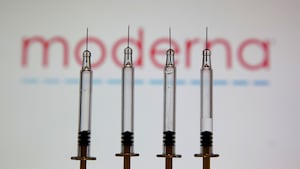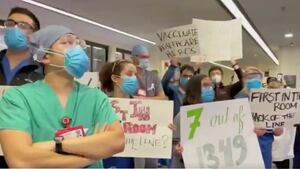As Vice President Mike Pence sat for his COVID-19 vaccine shot on Friday morning, governors’ offices across the country were fuming, confused as to why their states were set to receive significantly fewer Pfizer doses than originally expected.
For months, states worked with the federal government to iron out plans for how many doses they’d receive, where and when they’d be distributed, and who would get the shots first. Senior officials with Operation Warp Speed, a public-private partnership to fast-track a vaccine, touted the administration’s planning as a success, saying that the Centers for Disease and Control and Prevention (CDC) had worked with states to make the distribution go smoothly.
But within days of declaring an unambiguous triumph, things have gone seriously awry.
As vaccines have made their way from warehouses to hospitals across the country, state officials from Iowa, Kansas, Maryland, Michigan, Missouri, Nebraska, Georgia, and Washington State, among others, have been notified that they will receive thousands fewer doses than expected. Officials with two states told The Daily Beast that they would receive 30 percent less vaccine than planned. And when officials approached the federal government for answers, they said they were greeted with more confusion.
On Saturday, an apologetic General Gustave Perna, the chief operating officer of Operation Warp Speed, said he took “personal responsibility” for a miscommunication that led states to believe their allocations had somehow shrunk.
He cited a lag between when shots are produced and when they’re cleared for shipment as the reason for the confusion. In the first week of shipments, doses had already been checked for quality and were ready to go. But, as the second week rolled around, doses hadn’t been vetted so Perna said he had to “lower the allocations to meet the releaseable doses that were presented to me.”
The chaotic search for answers in recent days had extended up the ranks of the Trump COVID task force, where top members copped to being unaware as to why there were discrepancies between the numbers originally communicated to states and the number of doses shipped. As of Friday, the task force has not convened to discuss the issue, according to people familiar with the matter, even as a second vaccine from Moderna received its own emergency-use authorization.
The first signs of potential trouble became visible on a conference call with the nation’s governors earlier this week. On the call, top administration officials were bullish about the distribution plans in place.
“As the president often says, so far so good. Out of the gate strong,” said Pence, the head of the COVID task force, referring to the initial rollout of doses beginning last weekend.
But on the same call, Health and Human Services Secretary Alex Azar stressed the importance of vaccine shipping schedules being precise, noting that late shipments could screw up immunization plans since people needed the second dose to be there 21 days after the first. “It’s a bit more of a complex math problem,” he said, “than simply saying, ‘Go ahead and put 40 million doses out in December instead of 20 million.’”
Later in the call came an even clearer indication of logistical complications. North Carolina Governor Roy Cooper said that his state “still” didn’t have confirmation on the number of doses for the Pfizer vaccine for the second week of allocation. “It is really critical that we get those weekly allocation numbers as soon as we can,” he added.
Perna told Cooper that the government would post Pfizer shipping numbers for prospective states “no later than Friday,” after which the shipments would be sent on Monday.
“If there is any way to get them sooner than that it would be good,” Cooper said.
On Thursday, it was reported that the feds had responded to concerns about allocations coming too late in the week by moving up the date to Tuesday instead of Friday. Doing so, The New York Times reported, “meant that the federal government could not include in that shipping estimate additional vaccine batches that were released after Tuesday, according to a senior administration official.”
Echoing that point, the Department of Health and Human Services insisted on Friday that any concerns about vaccine distribution were incorrect and that reports of supply shortages were merely due to the fact that the shipments were still on their way.
“Reports that jurisdictions’ allocations are being reduced are incorrect. As was done with the initial shipments of Pfizer vaccine, jurisdictions will receive vaccine at different sites over several days,” a spokesperson for HHS said. “Operation Warp Speed allocation numbers locked in with states have not been changed or adjusted.”
The spokesperson said that vaccine allocations will depend “on the amount of vaccine available” and that the administration would let states know how many were available for order each week.
But a lingering question for state officials is whether the administration initially over promised on how many vaccines could be delivered in the early waves of delivery. The federal government gave some states projections in mid-November that were, an official said, twice as high as the number of doses those states will end up receiving. According to a recent report by McClatchy, a Pentagon system that tracks coronavirus vaccines, Tiberius, had outdated projections in place when distribution began, muddling the process and misleading governors on how many doses their states would receive.
Some states were provided revised numbers in mid-December, according to local officials who spoke with The Daily Beast. But the current projections still are falling short of what states had, for weeks, believed they would be receiving from Pfizer in week two.
The problem was serious enough that it prompted a direct call for action from the Biden transition team. “We need the Trump administration to act now to purchase the doses it has negotiated with Pfizer and Moderna and to work swiftly to scale manufacturing for the U.S. population and the world,” Biden transition executive director Yohannes Abraham said on a conference call.
By week’s end, news of potential shortages had filtered down to the local level, where health-care workers were left to anxiously wonder if they would be getting the doses they had been promised.
One emergency room nurse at Memorial West Hospital in Pembroke Pines, Florida, said about 50 percent of her co-workers in the emergency department signed up for the vaccine. The nurse, who got her first dose on Friday, said her hospital received 19,500 doses on Monday.
But if the state is getting far fewer vaccinations in the next two weeks than the administration of Gov. Ron DeSantis originally planned for, she was worried that she wouldn’t get her second dose in time for the vaccine to actually work.
“That’s crazy if we don’t get the next shot in time,” said the nurse, who spoke anonymously because she did not have permission from Memorial West to speak to the media. “The first vaccine only provides 50 percent immunity. If in 21 days, I can’t get the second dose, it will be a waste.”
A Memorial West spokesperson did not immediately respond to a request for comment.
The federal government’s COVID-19 vaccination program was always destined to be a herculean task. Against the backdrop of rising case numbers and accompanying deaths, government officials and allied scientists labored to find a vaccine in a record timeframe. But they also understood that distributing it would be a massive bureaucratic and logistical lift. And even before the Pfizer vaccine was approved, there were signs of problems ahead.
In several of the vaccine distribution plans reviewed by The Daily Beast, states raised shortage issues, underscoring how local health departments would need to manage expectations and public demand. In Michigan, officials said they were not releasing detailed information about the number of doses the state was expecting because they did not want to communicate vital vaccine information that may end up changing in the future.
The absence of lines of communication, experts say, has now manifested itself in the chaotic search for an explanation for the status of the doses. The distribution of the vaccine has caused tension in communities and even a demonstration at a major hospital in California, where frontline workers objected to administrators appearing to cut the line.
It has also led to the odd specter of the federal government and one of its chief vaccine manufacturers talking past each other in semi-cryptic statements to the press.
On Thursday, Pfizer said it had shipped all of its 2.9 million initial doses and it had “millions more doses sitting in our warehouse” waiting for “shipment instructions.” A senior administration official familiar with Operation Warp Speed’s planning said that all of the doses sitting in Pfizer warehouses were either earmarked for future shipments or were being held as “safety stock.”
Left unclear was why, if the 2.9 million initial doses had indeed been shipped, states were saying that they were set to receive fewer than expected. Not just because the expectation for weeks had been for that precise number to be available, but because there were reports that the vials Pfizer was distributing contained more doses than anticipated.
“This is an enormously complicated logistics challenge. It’s the most complicated vaccination program in American history. But there’s been a lack of alignment between federal and state governments,” said Tom Frieden, former director of the CDC in the Obama administration. “The CDC has been trying to do this [planning] for many months but has essentially been blocked by Operation Warp Speed.”
“Every step of the way,” he added, “there are things that could go wrong.”
—with reporting by Francisco Alvarado








